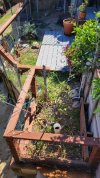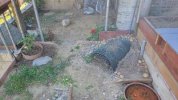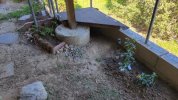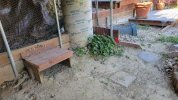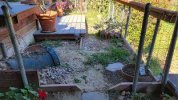My Elvis is a male desert tortoise between 20-40 years of age. When I took over Elvis as my ward a year and a half ago, he went straight into a double box for four months (November 1st). A novice, I was scared that he wouldn't survive... wrong. During that time I went to work on a tortoise garden with all the natural food, grasses, aloe, hibiscus, etc... I read would be either being beneficial or not toxic to injest. Elvis survived ME! Then it became clear to me that Elvis, and I must mention that I live in idealic southern California where it can get to the 30's at night and a blistering 105 during the summer heat, that my climes appear to be equal to the local deserts. Elvis is a pro. He survived way back then...figuring things out. So, I built three differant burrows so he could figure out which one would suit him when the sun is too much, or the rain to wet, or...ta da! His brumation period. His burrow that he selected goes into a slope about eight feet. He made his little mound to keep heavy rains out. He dug deeper so he could be more protected from predators. In middle November he crawled in and went to sleep. Lo and behold, the unusually warm weather, like many of your tortoises, caused Elvis to peak his head out to ungrog his tiny, sleepy brain earlier than normal. Elvis knows! Now he basks in the home I created for him. Dines on dandelion greens, hibiscus and dichondra and bermuda grass. And it's natural.... I get it. It doesn't work for everyone. But for where I live, it works for Elvis. He's a survivor!
You are using an out of date browser. It may not display this or other websites correctly.
You should upgrade or use an alternative browser.
You should upgrade or use an alternative browser.
Natural, or not, Brumation
- Thread starter Elvis Fan
- Start date
It would should work, he is a native to your state. Only those that live in their native states can have them. Those of us that have the other kind of brumating/hibernating tortoises don't have that convience of living in their home country.
Glad to see you made it thru. That's the part I would hate the most, the worry. Many just don't make it.
Glad to see you made it thru. That's the part I would hate the most, the worry. Many just don't make it.
This isn't correct. Somebody's back yard isn't the wild, and Whittier is a long way from Mojave.The temps are to the same, and in Mojave, they spend most of their time underground out of the extremes. In the wild they'd be 30 feet down a burrow, or more, and more than 10 feet under ground. The ground temps are very stable down there and don't change much once they hit the winter low of around 50 degrees. Warm spells at the surface, or nights below freezing have no effect on them. Trapped in a small backyard, they can't do what they need to do or go where they need to go to brumate correctly. Some of them get lucky and manage to survive for a few years, and then they don't. Floods, rodents, high or low temps, burrow collapse, etc...It would should work, he is a native to your state. Only those that live in their native states can have them. Those of us that have the other kind of brumating/hibernating tortoises don't have that convience of living in their home country.
Glad to see you made it thru. That's the part I would hate the most, the worry. Many just don't make it.
You are literally gambling with his life doing it this way. I can't count how many people I've had this argument with. They get all indignant telling me that their tortoise has survive this way for X number of years, and then one year it doesn't. So many people lose them this way. Pull your tortoise in the fall and give him the correct lead in to brumation, constant cold brumation temps for the entire duration, and then the correct lead out of brumation.My Elvis is a male desert tortoise between 20-40 years of age. When I took over Elvis as my ward a year and a half ago, he went straight into a double box for four months (November 1st). A novice, I was scared that he wouldn't survive... wrong. During that time I went to work on a tortoise garden with all the natural food, grasses, aloe, hibiscus, etc... I read would be either being beneficial or not toxic to injest. Elvis survived ME! Then it became clear to me that Elvis, and I must mention that I live in idealic southern California where it can get to the 30's at night and a blistering 105 during the summer heat, that my climes appear to be equal to the local deserts. Elvis is a pro. He survived way back then...figuring things out. So, I built three differant burrows so he could figure out which one would suit him when the sun is too much, or the rain to wet, or...ta da! His brumation period. His burrow that he selected goes into a slope about eight feet. He made his little mound to keep heavy rains out. He dug deeper so he could be more protected from predators. In middle November he crawled in and went to sleep. Lo and behold, the unusually warm weather, like many of your tortoises, caused Elvis to peak his head out to ungrog his tiny, sleepy brain earlier than normal. Elvis knows! Now he basks in the home I created for him. Dines on dandelion greens, hibiscus and dichondra and bermuda grass. And it's natural.... I get it. It doesn't work for everyone. But for where I live, it works for Elvis. He's a survivor!
This thread shows how to make a tortoise house that will help you do this correctly, and defeat mother natures cruel and fickle whims of weather in the fall and spring.
The Best Way To Raise Any Temperate Species Of Tortoise
I chose the title of this care sheet very carefully. Are there other ways to raise babies and care for adults? Yes. Yes there are, but those ways are not as good. What follows is the BEST way, according to 30 years of research and experimentation with hundreds of babies of many species. What is...
I invite questions and discussion on the matter. My goal is to help as many DTs as possible survive and thrive. I don't want to see any more of them die, including yours.
I didnt pat attention to where he lived except CA. I figured they were all over most of that area, beside just being native to certain areas of CA.This isn't correct. Somebody's back yard isn't the wild, and Whittier is a long way from Mojave.The temps are to the same, and in Mojave, they spend most of their time underground out of the extremes. In the wild they'd be 30 feet down a burrow, or more, and more than 10 feet under ground. The ground temps are very stable down there and don't change much once they hit the winter low of around 50 degrees. Warm spells at the surface, or nights below freezing have no effect on them. Trapped in a small backyard, they can't do what they need to do or go where they need to go to brumate correctly. Some of them get lucky and manage to survive for a few years, and then they don't. Floods, rodents, high or low temps, burrow collapse, etc...
You are literally gambling with his life doing it this way. I can't count how many people I've had this argument with. They get all indignant telling me that their tortoise has survive this way for X number of years, and then one year it doesn't. So many people lose them this way. Pull your tortoise in the fall and give him the correct lead in to brumation, constant cold brumation temps for the entire duration, and then the correct lead out of brumation.
This thread shows how to make a tortoise house that will help you do this correctly, and defeat mother natures cruel and fickle whims of weather in the fall and spring.
The Best Way To Raise Any Temperate Species Of Tortoise
I chose the title of this care sheet very carefully. Are there other ways to raise babies and care for adults? Yes. Yes there are, but those ways are not as good. What follows is the BEST way, according to 30 years of research and experimentation with hundreds of babies of many species. What is...tortoiseforum.org
I invite questions and discussion on the matter. My goal is to help as many DTs as possible survive and thrive. I don't want to see any more of them die, including yours.
My apologies. I guess that explains my last statement about many not making.
They only occur in a few small areas out in the desert. Much of their habitat has been lost to the military and other human destruction. They seem to cluster in certain pockets, and seemingly similar terrain relatively close to them will be completely tortoise free. The climate changes drastically as you move closer to the coast.I didnt pat attention to where he lived except CA. I figured they were all over most of that area, beside just being native to certain areas of CA.
My apologies. I guess that explains my last statement about many not making.
That is one of the appealing things about CA. You can go surfing in the morning, snow skiing in the afternoon, and then drive out to the desert to make camp and sleep. I've done this a time or two.
I appreciate all the feed-back from those who have more experience. I will pay attention. I should also have included that I did protect the burrow from wind, cold and critters to the best of my ability, once I was certain that Elvis was down for brumation. The average temp down in the burrow during the brumation period was 48-52 degrees.
Similar threads
- Replies
- 2
- Views
- 1K
- Replies
- 10
- Views
- 1K
- Replies
- 12
- Views
- 2K
New Posts
-
Setting up for a Russian Tortoise - Constructive comments welcome
- Latest: _The_Beast_
-
-
-
-

